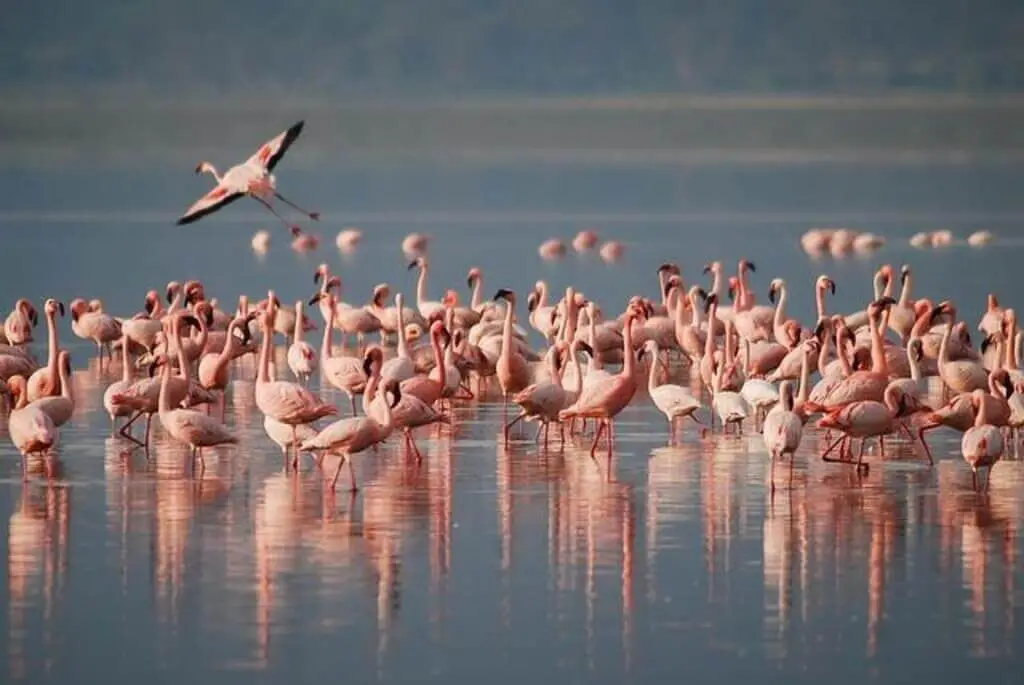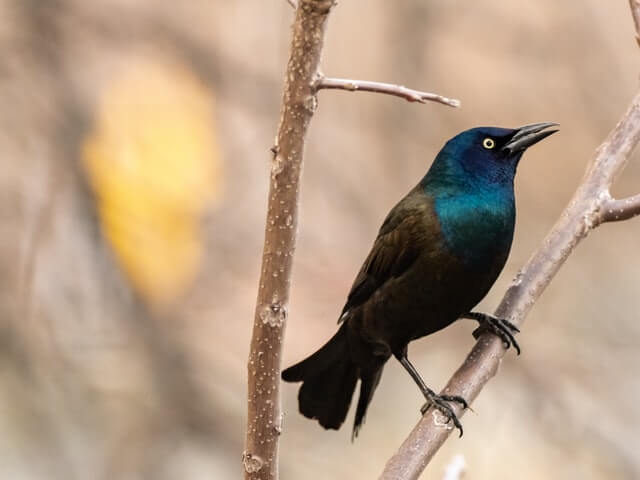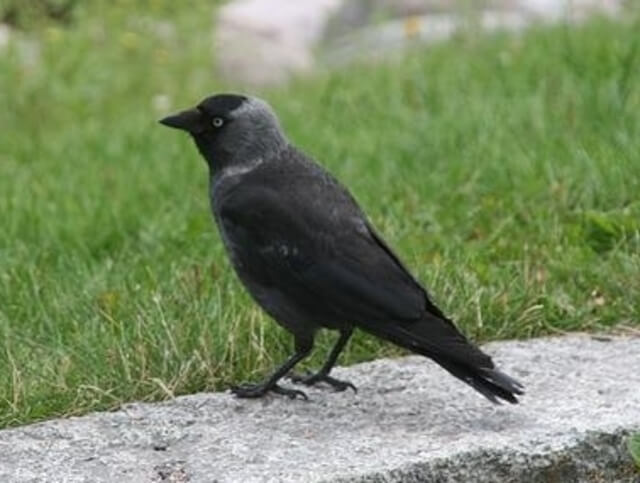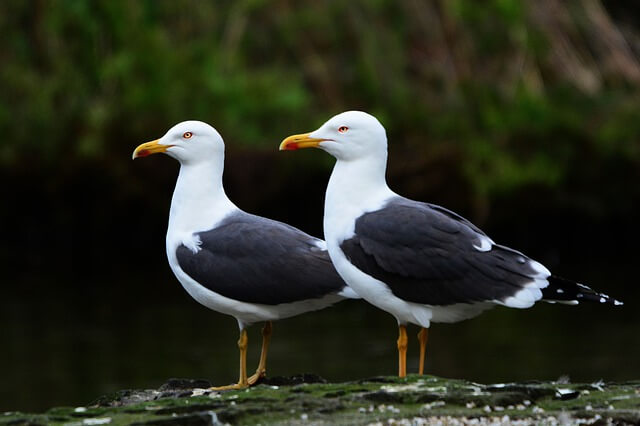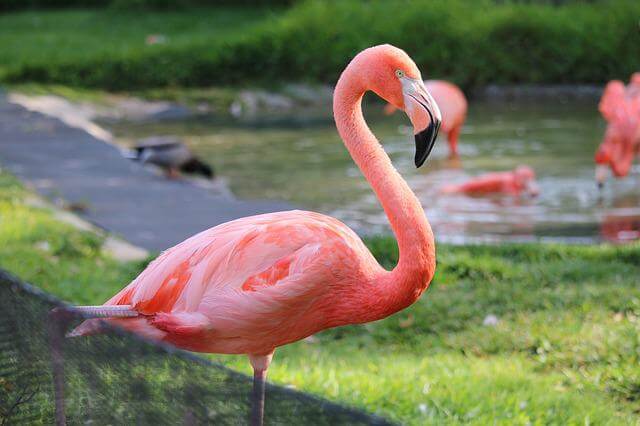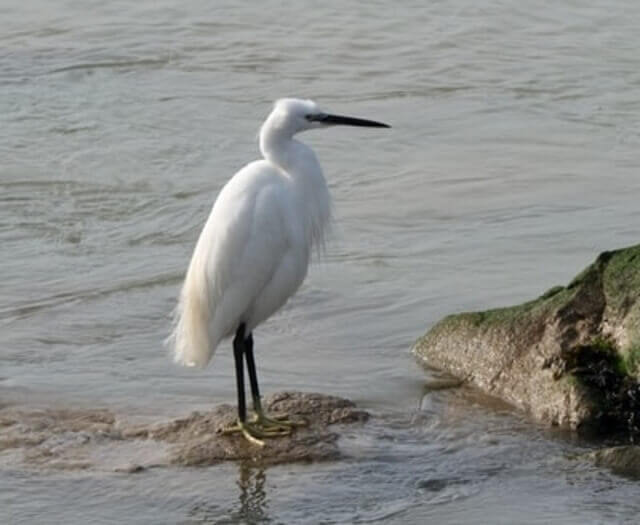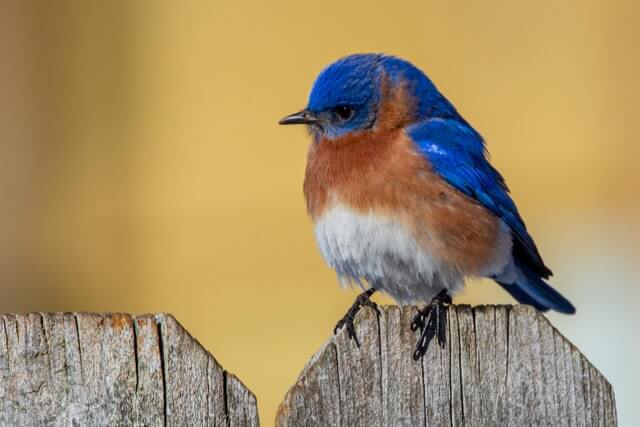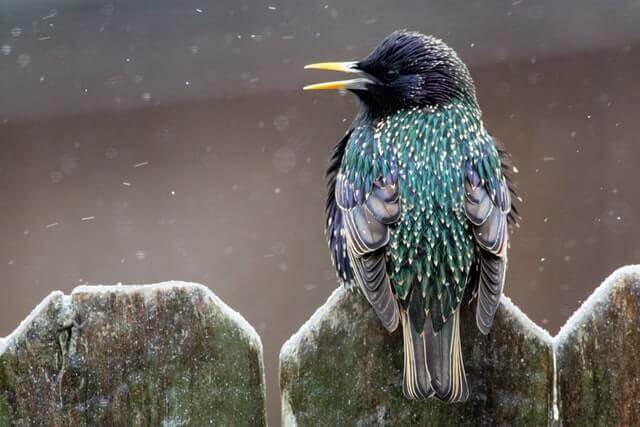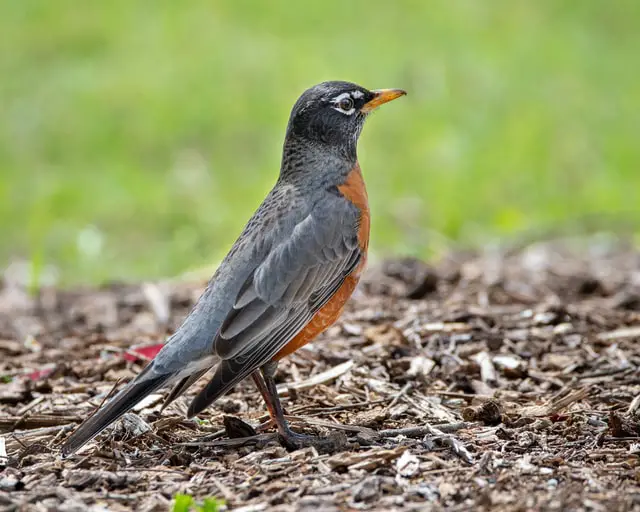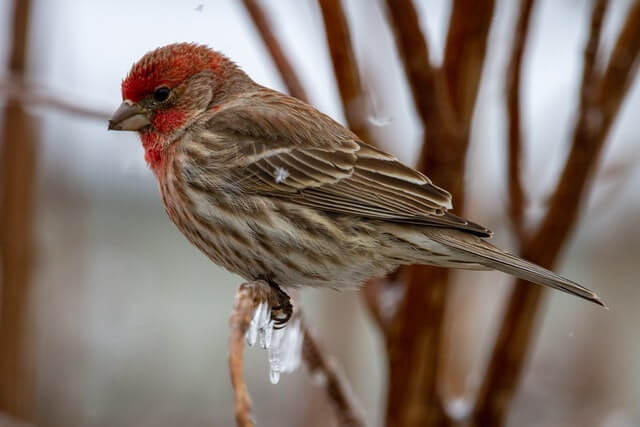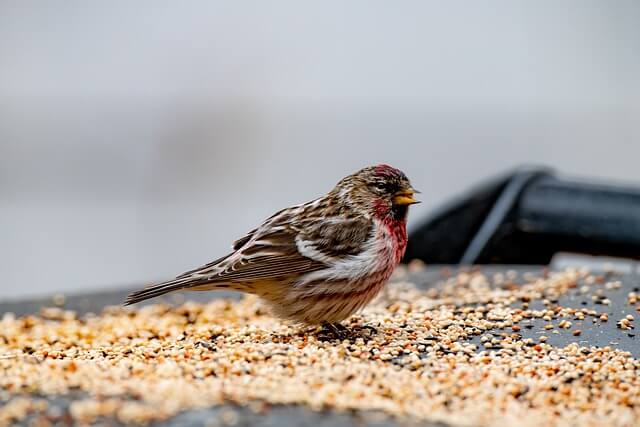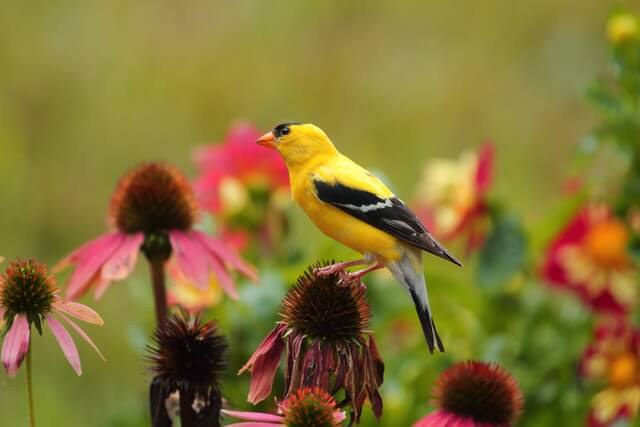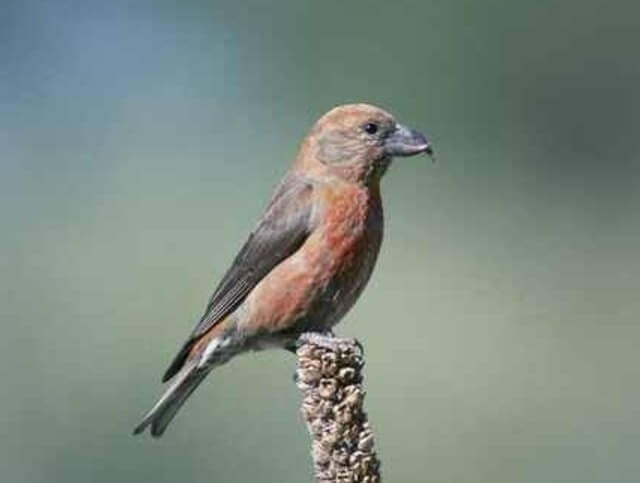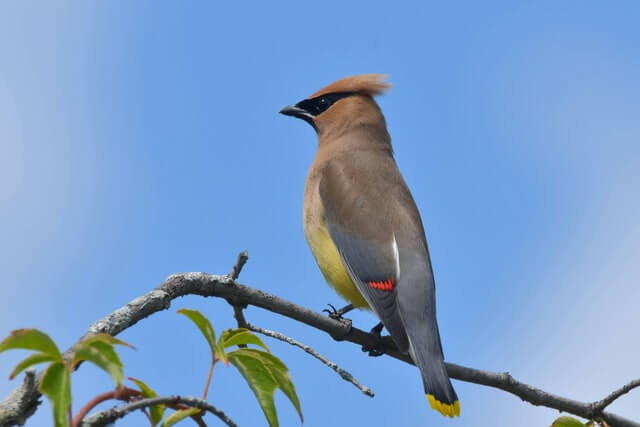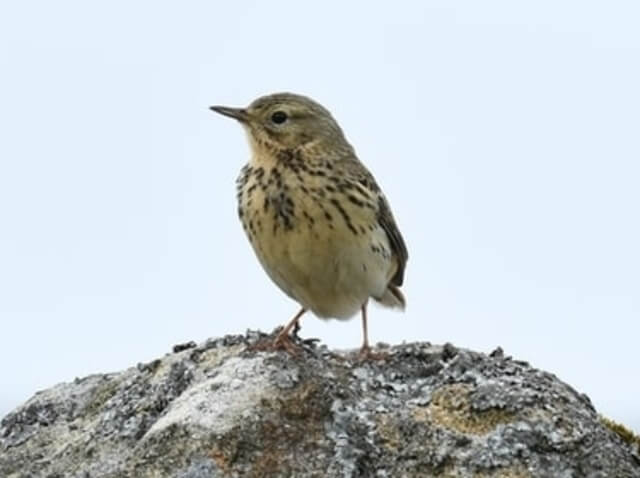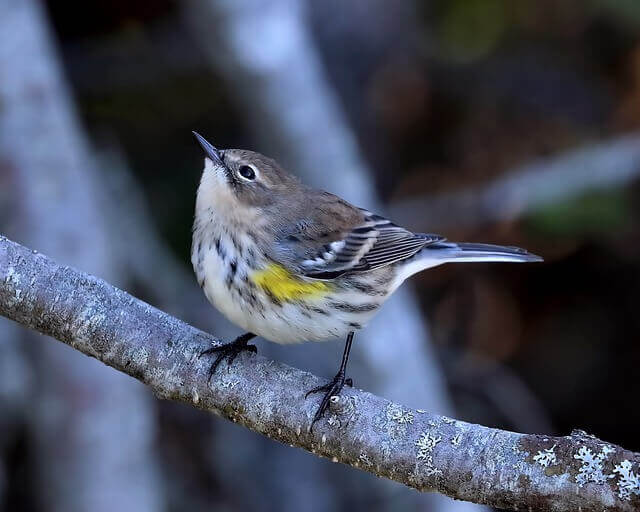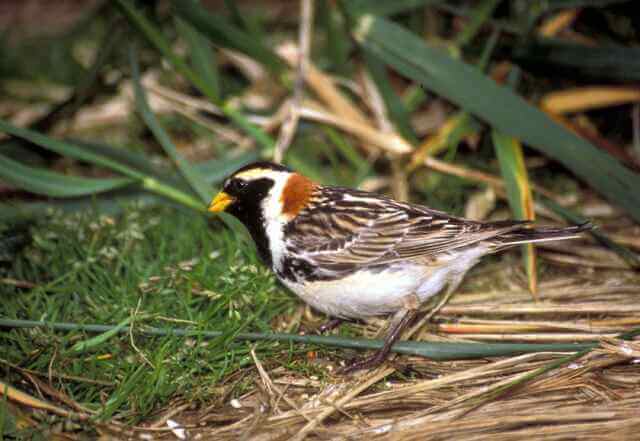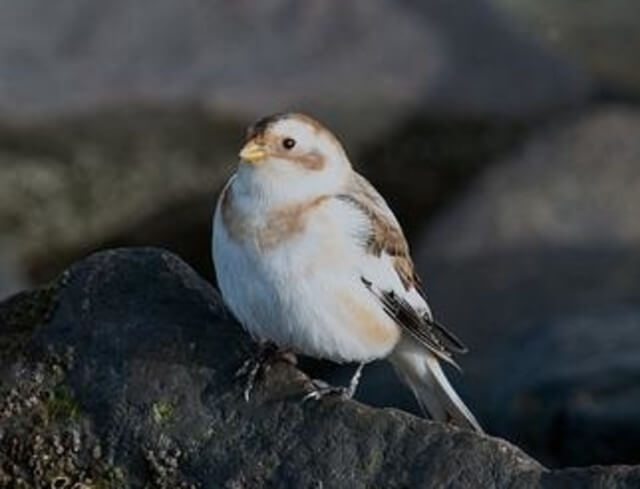Birds are fascinating creatures, and one of their most intriguing behaviors is their tendency to flock together. Flocking behavior can be observed in birds of all shapes and sizes, from tiny hummingbirds to giant pelicans. But why do they do it? In this article, we’ll explore the various reasons why birds flock and the science behind this behavior.
Table of Contents
Larger Birds That Flock Together
Common Grackle
Common Grackles, scientifically known as Quiscalus quiscula, are captivating avian species with distinctive flocking behavior. These medium-sized birds are known for their striking iridescent plumage and often congregate in large, dynamic groups. Common Grackles display partially migratory behavior, with some populations remaining year-round in their chosen habitats and others embarking on seasonal migrations.
During non-breeding seasons, they frequently gather in sizable, swirling flocks, engaging in synchronized foraging and movement patterns that efficiently locate food sources and provide a collective defense against potential threats. This flocking behavior highlights the remarkable social dynamics of these avian creatures within their ecosystems.
Brown–headed Cowbird
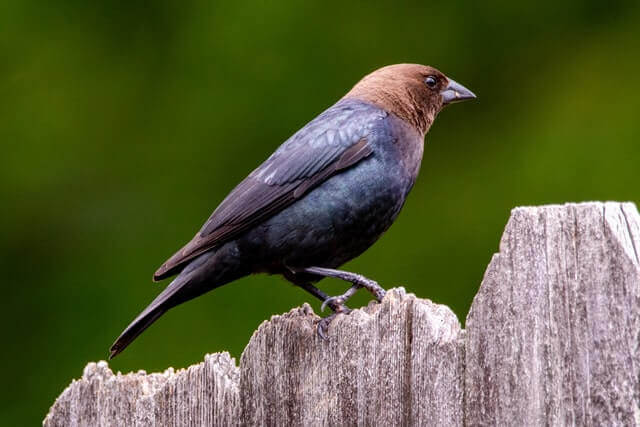
The Brown-headed Cowbird, scientifically known as Molothrus ater, is a captivating avian species with distinctive flocking behavior. These birds are recognized for their striking brown plumage and are commonly found across North America. Brown-headed Cowbirds are primarily non-migratory, residing year-round in their chosen habitats.
During the non-breeding season, they often come together in loose flocks, engaging in communal foraging, sharing information about food sources, and providing a collective sense of security against potential threats. This flocking behavior is a testament to their adaptability and social interactions within their ecosystems.
Western Jackdaw
The Western Jackdaw, scientifically known as Corvus monedula, is a captivating avian species with distinctive flocking behavior. These small, black-plumaged birds are commonly found in various regions across Europe and parts of Asia. Western Jackdaws are primarily non-migratory, tending to stay in their preferred habitats year-round, forming resident populations.
During the non-breeding season, they often come together in loose flocks, engaging in communal foraging, sharing information about food sources, and providing a collective sense of security against potential threats. This flocking behavior is a testament to their adaptability and social interactions within their ecosystems.
Shorebirds
Shorebirds, scientifically known as Charadriiformes, are intriguing avian species with unique flocking behavior. These birds are commonly found in coastal and wetland habitats and come in a variety of shapes, sizes, and plumage colors. Shorebirds exhibit a combination of migratory and non-migratory behaviors, with some populations staying year-round in their preferred coastal environments and others undertaking long-distance migrations.
During non-breeding seasons, they frequently congregate in loose flocks along shorelines and mudflats, where they engage in collective foraging, sharing information about food sources, and providing a communal defense against potential predators. This flocking behavior underscores the adaptability and social interactions of these avian species within their coastal ecosystems.
Flamingos
Flamingos, known for their iconic pink plumage and distinctive appearance, are captivating avian species with unique flocking behavior. These wading birds are often found in wetlands, lakes, and coastal regions, where they form impressive congregations. Flamingos are known for their partially migratory tendencies, with some populations staying year-round in their chosen habitats and others engaging in seasonal migrations.
During non-breeding seasons, they frequently assemble in large and strikingly colorful flocks, exhibiting cooperative foraging behaviors and forming visually stunning formations. This flocking behavior not only aids in efficient foraging but also provides a sense of safety and social interaction within their ecosystems, showcasing the unique dynamics of these magnificent birds.
Cranes
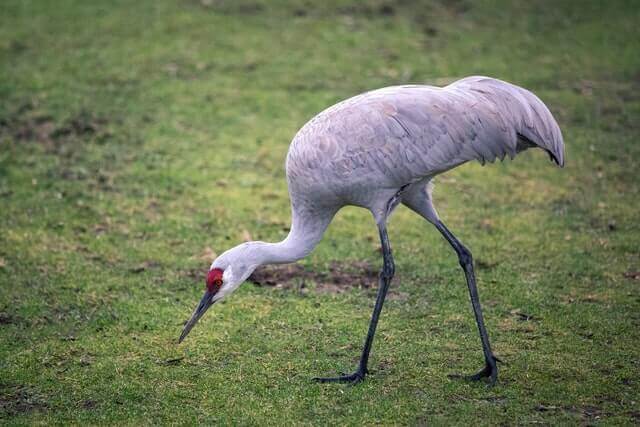
Cranes, known scientifically as Gruidae, are elegant avian species with distinctive flocking behavior. These tall, graceful birds are renowned for their long legs and distinctive calls. Cranes exhibit both migratory and non-migratory tendencies, with some populations residing year-round in their chosen habitats and others embarking on long-distance migrations.
During non-breeding seasons, they often come together in large flocks, forming V-shaped formations during flight. This flocking behavior serves the purpose of efficient foraging and navigation during migration, allowing them to collectively sense potential threats. The adaptability and coordination within these flocks provide a captivating insight into the social dynamics of these avian creatures within their ecosystems.
Egrets
Egrets, graceful avian species, are known for their striking white plumage and long, slender bills. They exhibit distinctive flocking behavior, with some populations being migratory while others are resident year-round in their preferred wetland habitats. During non-breeding seasons, Egrets often come together in loose flocks, engaging in synchronized foraging along the water’s edge.
This cooperative behavior not only helps them locate and capture prey more effectively but also offers an additional layer of protection against potential threats. The adaptability and social interactions within these flocks highlight the fascinating dynamics of Egrets within their wetland ecosystems.
Stilts
Stilts, scientifically known as Himantopus, are remarkable avian species with distinct flocking behavior. These long-legged birds are known for their striking appearances and are often found near wetlands and shallow waters. Stilts typically form non-migratory populations, residing year-round in their preferred habitats.
During the non-breeding season, they gather in loose flocks, engaging in communal foraging and maintaining a collective sense of security. This flocking behavior is essential for efficiently locating food sources and providing protection against potential threats, highlighting the adaptability and social interactions within their ecosystems.
Pigeons
Pigeons, scientifically known as Columba livia, display intriguing flocking behavior. These birds, often seen in urban environments worldwide, are medium-sized and known for their distinct cooing sounds. Pigeons are typically non-migratory, residing year-round in their chosen habitats, particularly in cities.
During non-breeding seasons, they congregate in sizable flocks, demonstrating coordinated flight patterns while foraging efficiently. This flocking behavior not only aids in locating food sources but also offers a collective defense against potential threats. It highlights the adaptability and social interactions of pigeons within their urban ecosystems.
Pelicans
Pelicans, known scientifically as Pelecanidae, are remarkable avian species characterized by their distinctive physical features and fascinating flocking behavior. These large water birds are recognized for their long bills and expansive wingspans, making them a captivating sight along coastlines and bodies of water. Pelicans often gather in loose flocks, particularly during their non-breeding seasons.
Their communal foraging behavior enables them to effectively locate and capture fish and other aquatic prey. This flocking tendency also provides them with an additional layer of protection against potential threats. The social interactions and coordinated efforts within these flocks highlight the adaptability of these birds in their aquatic ecosystems.
Small Birds That Flock Together
Common Blackbird
The Common Blackbird, scientifically known as Turdus merula, is a captivating avian species with distinct flocking behavior. These birds are known for their striking black plumage and melodious songs, and they are commonly found across Europe and parts of Asia. Common Blackbirds are primarily non-migratory, tending to stay in their preferred habitats year-round, forming resident populations in various regions.
During the non-breeding season, they come together in loose flocks, engaging in communal foraging, sharing information about food sources, and providing a collective sense of security against potential threats. This flocking behavior is a testament to their adaptability and social interactions within their ecosystems.
Eastern Bluebird
The Eastern Bluebird, scientifically known as Sialia sialis, is a captivating avian species with distinct flocking behavior. These small, vividly colored birds are native to North America, highly regarded for their striking blue plumage and sweet, melodious songs. Eastern Bluebirds exhibit partially migratory behavior, with some populations residing year-round in their chosen habitats and others undertaking seasonal migrations.
During non-breeding seasons, they occasionally gather in small loose flocks, engaging in cooperative foraging, sharing information about food sources, and providing a collective sense of security against potential threats. This flocking behavior is a testament to their adaptability and social interactions within their ecosystems.
Common Starling
Common Starlings, scientifically known as Sturnus vulgaris, exhibit captivating flocking behavior. These medium-sized birds are known for their iridescent plumage and often gather in mesmerizing murmurations. Starlings display both migratory and non-migratory tendencies, with some populations residing year-round in their chosen habitats and others embarking on seasonal migrations.
During non-breeding seasons, they frequently come together in large, swirling flocks, engaging in synchronized flight patterns that serve the purpose of foraging efficiently and providing a collective defense mechanism against potential threats. This flocking behavior showcases the remarkable social dynamics of these avian creatures within their ecosystems.
American Robin
American Robins, known scientifically as Turdus migratorius, exhibit captivating flocking behavior. These migratory birds are well-known for their distinctive orange-red breast and melodious songs. While some American Robin populations reside year-round in their habitats, those that breed in Canada and Alaska undertake migrations to Mexico and Central America during the winter months. However, these birds don’t solely rely on migration to flock.
They actively come together during the day and assemble in large groups at night. This flocking behavior not only aids in foraging but also enhances their collective vigilance against potential predators. The adaptability and social interactions within these flocks provide valuable insights into the lives of these iconic birds within their ecosystems.
House Finch
The House Finch, scientifically known as Haemorhous mexicanus, exhibits captivating flocking behavior. These small, sparrow-sized birds are known for their adaptable nature and cheerful songs. House Finches are primarily non-migratory, with many populations residing year-round in their preferred urban and suburban habitats.
During the non-breeding season, they often gather in small, loose flocks, engaging in cooperative foraging, sharing information about food sources, and providing a collective sense of security against potential threats. This flocking behavior highlights the adaptability and social interactions of these birds within their human-altered environments.
Common Redpoll
Common Redpolls, scientifically known as Acanthis flammea, are captivating avian species with their unique flocking behavior. These small finches are known for their charming crimson plumage and lively chirping. Common Redpolls are migratory birds that breed in the northern regions of North America and Eurasia, with some populations residing year-round in their preferred habitats, while others embark on seasonal migrations to find food.
During non-breeding seasons, they often assemble in small, bustling flocks, engaging in cooperative foraging, sharing information about food sources, and creating a collective sense of security against potential threats. This flocking behavior highlights the adaptability and social interactions within their ecosystems.
Pine Siskin
Pine Siskins, scientifically known as Spinus pinus, are captivating avian species with distinctive flocking behavior. These small, finch-like birds are often characterized by their brown plumage streaked with fine lines. Pine Siskins exhibit migratory behavior, with populations varying in their movements. Some Pine Siskins remain in their habitats year-round, while others embark on seasonal migrations.
During non-breeding seasons, they come together in loose flocks, displaying cooperative foraging behavior and sharing information about food sources. This flocking behavior not only facilitates efficient feeding but also enhances their safety by providing a collective defense against potential threats.
American Goldfinch
The American Goldfinch, scientifically known as Spinus tristis, showcases captivating flocking behavior. These small, brightly colored birds are native to North America and are celebrated for their vibrant yellow plumage. American Goldfinches are typically non-migratory, residing year-round in their preferred habitats.
During non-breeding seasons, they often come together in loose flocks, engaging in communal foraging and sharing information about food sources. This flocking behavior not only helps them locate sustenance efficiently but also provides a collective sense of security against potential threats. It underscores the adaptability and social interactions within their ecosystems.
Red Crossbill
The Red Crossbill, scientifically known as Loxia curvirostra, is a captivating avian species with unique flocking behavior. These birds are easily recognizable by their distinctive crossed bills, which they use for extracting seeds from conifer cones. Red Crossbills are known for their nomadic tendencies, often moving in search of coniferous forests and food sources.
During non-breeding seasons, they tend to form loose flocks, engaging in cooperative foraging and providing a collective sense of security against potential threats. This flocking behavior not only enables efficient feeding but also emphasizes their adaptability and social interactions within their ecosystems.
Cedar Waxwing
Cedar Waxwings, scientifically known as Bombycilla cedrorum, are captivating avian species with unique flocking behavior. These sleek, crested birds are known for their elegant appearance and melodious calls. Cedar Waxwings are generally non-migratory, residing year-round in their preferred habitats across North America.
During non-breeding seasons, they often come together in small to large flocks, engaging in cooperative foraging, sharing information about food sources, and providing a collective sense of security against potential threats. This flocking behavior not only aids them in locating and accessing food more efficiently but also highlights their remarkable social interactions within their ecosystems.
Pipits
Pipits, scientifically known as Anthus, are captivating avian species with unique flocking behavior. These slender, small- to medium-sized birds are often found in open habitats. Pipits exhibit diverse behaviors regarding migration, with some populations being migratory while others remain in their preferred habitats year-round.
During non-breeding seasons, they commonly gather in loose flocks, using their collective efforts to forage efficiently and share information about food sources. This communal behavior not only aids in finding sustenance but also provides protection against potential threats. The adaptability and social interactions within these flocks offer valuable insights into the lives of these avian creatures and their role within their ecosystems.
Yellow-rumped Warbler
The Yellow-rumped Warbler, scientifically known as Setophaga coronata, showcases captivating flocking behavior. These small, colorful birds are native to North America and are distinguished by their striking plumage. Yellow-rumped Warblers exhibit both migratory and non-migratory habits, with some populations residing year-round in their chosen habitats, while others undertake seasonal migrations.
During non-breeding seasons, they often come together in loose flocks, cooperating in foraging activities, sharing information about food sources, and providing a collective sense of safety against potential threats. This flocking behavior is a testament to their adaptability and social interactions within their ecosystems.
House Sparrow
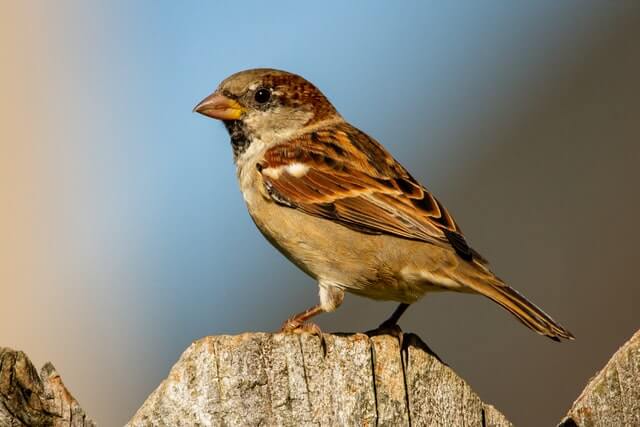
House Sparrows, scientifically known as Passer domesticus, are captivating avian species with unique flocking behavior. These small, adaptable birds are found worldwide and are known for their brown and gray plumage. House Sparrows are primarily non-migratory, residing in their chosen urban and suburban habitats throughout the year.
During the non-breeding season, they often come together in loose flocks, engaging in cooperative foraging, sharing information about food sources, and providing a collective sense of security against potential threats. This flocking behavior demonstrates their adaptability and social interactions within the environments they have come to inhabit.
Longspurs
Longspurs, scientifically known as Calcarius, are captivating avian species known for their distinctive flocking behavior. These medium-sized birds are often found in open grasslands and prairies, making them a familiar sight in North America. Longspurs exhibit migratory tendencies, with some populations embarking on long-distance migrations, particularly during the breeding season, while others may remain in their habitats year-round.
During the non-breeding season, Longspurs frequently come together in small to medium-sized flocks, where they engage in cooperative foraging, share information about food sources, and provide a collective sense of security against potential threats. This flocking behavior not only aids in efficient foraging but also exemplifies their adaptability and social interactions within their ecosystems.
Snow Bunting
Snow Buntings, scientifically known as Plectrophenax nivalis, are captivating avian species with unique flocking behavior. These small, strikingly white birds are known for their wintry appearances and often gather in sizable flocks. Snow Buntings exhibit migratory tendencies, with populations breeding in the Arctic regions and undertaking extensive migrations to more temperate areas during the winter.
During non-breeding seasons, they come together in large flocks, displaying cooperative foraging behaviors and providing a collective defense mechanism against potential threats. This flocking behavior not only aids in efficient foraging but also underscores the importance of their social interactions within their ecosystems.
Meadowlarks
Meadowlarks, scientifically known as Sturnella, are captivating avian species with unique flocking behavior. These birds are known for their distinctive songs and striking plumage. Meadowlarks exhibit primarily non-migratory tendencies, residing year-round in their preferred habitats.
During non-breeding seasons, they occasionally come together in loose flocks, engaging in cooperative foraging, sharing information about food sources, and providing a collective sense of security against potential threats. This flocking behavior highlights their adaptability and social interactions within their ecosystems.
Why do Birds Flock Together?
Birds exhibit fascinating flocking behaviors for various reasons, including protection, feeding, and social interaction. Explore the compelling dynamics behind these avian gatherings in this section.
Protection and Safety
One of the fundamental reasons behind avian flocking is the pursuit of safety and protection. The advantages of strength in numbers become evident as birds band together, collectively reducing the perils posed by predators.
The logic is simple: it’s far more challenging for a predator to single out and apprehend a specific bird when multiple potential targets are present. Moreover, communal vigilance contributes to enhanced safety within the group, as individuals can alert one another to potential threats.
Types of Flocks
Birds exhibit diverse flocking behaviors, often influenced by their species and environmental circumstances. Some notable categories include:
- Mixed-Species Flocks: These gatherings feature a mix of bird species foraging together. In wooded regions, different avian species often join forces in search of sustenance. This unity offers a defense through numbers and can present opportunities for more efficient foraging.
- Single-Species Flocks: At times, birds of a single species unite into vast flocks, commonly observed during migration. Large assemblies provide security and aid in navigation.
- Family Groups: Some avian species organize into flocks comprised of kin, such as parents and their offspring. This arrangement fosters the protection and transmission of vital knowledge and behaviors from one generation to the next.
Foraging and Feeding
Birds also congregate to optimize their foraging and feeding endeavors. In a quest for sustenance, the advantages of flocking are multifaceted:
- Enhanced Coverage: Groups of birds can survey a larger territory, significantly increasing their chances of locating food resources.
- Information Sharing: Within flocks, birds learn from each other and exchange valuable intelligence on the whereabouts of food sources.
Feeding Strategies
Distinct avian species employ diverse feeding strategies, influencing their flocking patterns:
- Scavenging: Birds with scavenging tendencies, like vultures and gulls, may gather around a food source, such as a carcass, ensuring efficient consumption.
- Seed-Eating: Species like finches and sparrows, which primarily feed on seeds, flock together to exploit abundant seed patches, such as sunflowers or thistle.
- Insect-Eating: Birds with insect-based diets, including swallows and swifts, may form flocks to engage in aerial hunts for insects.
Mating and Socialization
Flocking isn’t solely a matter of survival; it also plays a pivotal role in avian courtship and socialization:
- Leks and Courtship: During the breeding season, certain bird species create leks, congregations of males striving to attract females. These displays can involve dozens or even hundreds of males, all vying for the attention of potential mates.
- Social Bonds: Beyond mating, birds may flock for social activities. Highly social species come together to roost, preen, and engage in various communal behaviors. For example, the mesmerizing murmurations of starlings involve thousands of birds flying in synchronized patterns, captivating observers with their harmonious aerial ballet.
Bird Migration and Social Behavior
| Bird Name | Migration Behavior | Social Behavior |
|---|---|---|
| Common Grackle | Short distance | Flocks in large groups |
| Brown-headed Cowbird | Medium distance | Flocks in large groups |
| Western Jackdaw | Short distance | Flocks in large groups |
| Shorebirds | Long distance | Flocks in large groups |
| Flamingos | Short distance | Flocks in large groups |
| Cranes | Long distance | Flocks in small groups |
| Egrets | Short distance | Solitary or small groups |
| Stilts | Short distance | Flocks in small groups |
| Pigeons | Short distance | Flocks in large groups |
| Pelicans | Short distance | Flocks in small groups |
| Blackbirds | Medium distance | Flocks in large groups |
| Bluebirds | Short distance | Solitary or small groups |
| Starlings | Short distance | Flocks in large groups |
| American Robins | Short distance | Flocks in small groups |
| House Finch | Short distance | Flocks in small groups |
| Common Redpolls | Long distance | Flocks in small groups |
| Pine Siskins | Medium distance | Flocks in small groups |
| American Goldfinches | Short distance | Flocks in small groups |
| Red Crossbill | Irregular | Flocks in small groups |
| Cedar Waxwings | Short distance | Flocks in small groups |
| Pipits | Long distance | Flocks in small groups |
| Yellow-rumped Warbler | Long distance | Solitary or small groups |
| Sparrows | Short distance | Flocks in small groups |
| Longspurs | Long distance | Flocks in small groups |
| Snow Bunting | Long distance | Flocks in large groups |
| Meadowlarks | Short distance | Flocks in small groups |

